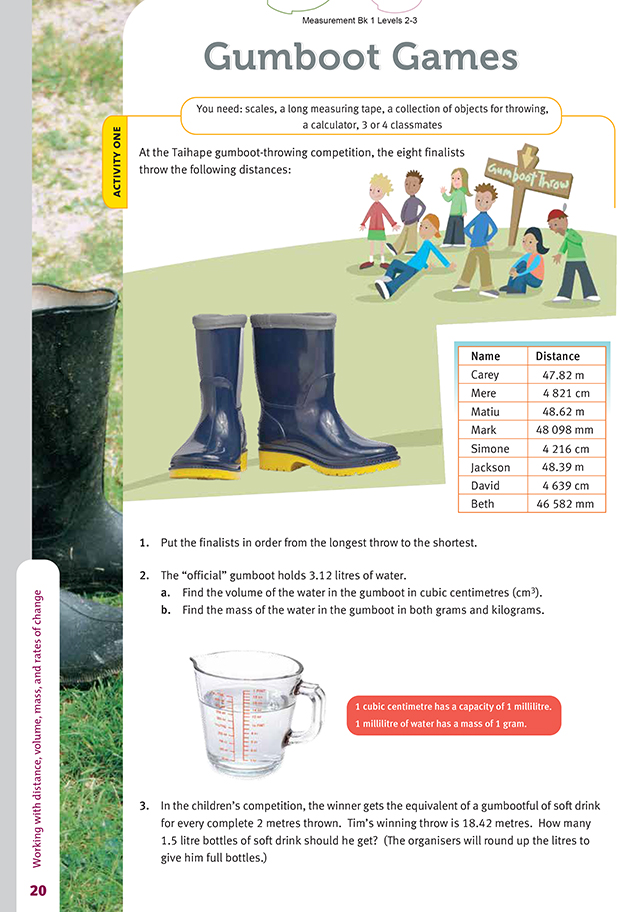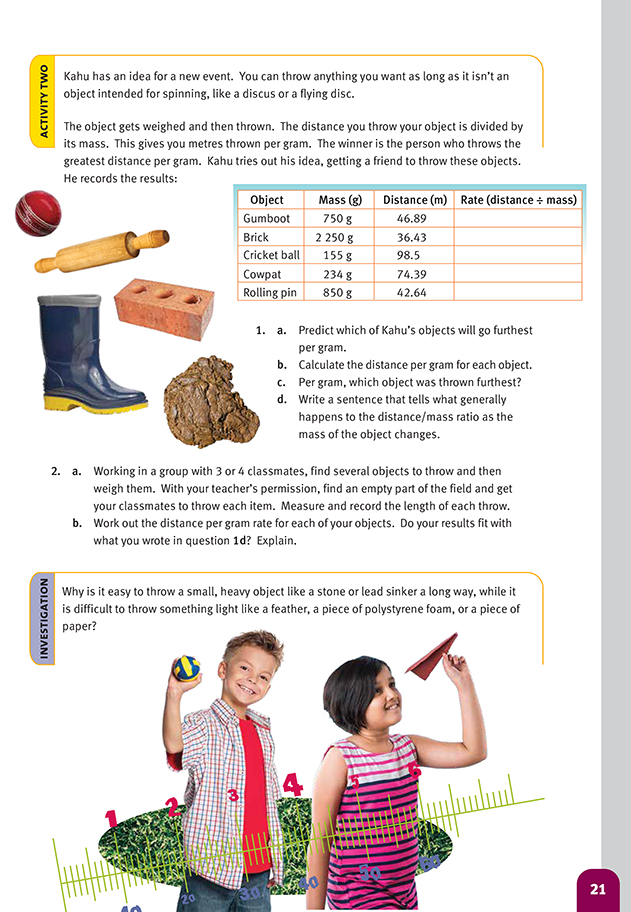This is a level 5 measurement strand activity from the Figure It Out series.
A PDF of the student activity is included.
Click on the image to enlarge it. Click again to close. Download PDF (367 KB)
order distances
use rates to solve problems involving measuring units
collection of objects for throwing
scales, long measuring tape
FIO, Level 4+, Measurement, Book Two, Gumboot Games, pages 20 -21
calculator
3 or 4 classmates
In these activities, the students explore mass and distance and, using ratio, develop simple ideas related to density and aerodynamics. They do some outdoor, practical experimentation, weighing, throwing, measuring, and recording.
Activity One
Question 1 challenges the students to compare distances expressed in three different units.
In question 2, they revisit the volume/mass equivalence that they explored in several activities in Measurement: Book One, Figure It Out, Years 7-8.
In question 3, the students must round up because of the practical realities of the situation. Discuss this with the class because, in everyday life, this kind of rounding is commonplace: you can't hire 1.25 taxis to carry 5 people, and you canÕt buy 1.4 cans of tomato paste when a recipe calls for this amount.
Activity Two
Question 1 asks the students to predict before they calculate. Suggest that they round their calculations to 3 decimal places (as in the Answers).
In question 1d, the students should make a statement that is consistent with all their data. Most will write a statement that says the heavier the object, the lower the throw rate. Some may also discuss the aerodynamics of the objects.
In question 2, the students collect their own data and see if it is consistent with the information they were originally given. With all this throwing about to take place, make sure that everyone is clear on the safety rules and that the activity is well supervised. If time permits, the students could throw each object a number
of times and then find the average distance covered. If they throw a wide variety of objects, they are likely to find their earlier hypothesis challenged by very light objects, and they may want to replace it with one that says there is an optimum mass that gives a maximum throw rate.
Investigation
The answer to this question is a complex interplay of factors. The students need to explore aerodynamics, mass, and density. They can bring their own experiences and observations to a discussion on this issue. Very light objects are very subject to air resistance (which is why they blow around so easily in a wind). Many students know that if they screw a piece of paper into a tight ball or make it into a dart, it will go further. This is because they have reduced the air resistance (improved the aerodynamics).
For a detailed discussion of the relevant concepts, see Building Science Concepts Book 30, The Air Around Us and Book 34, Parachutes.
Cross-curricular links
Science This activity could be part of a unit on aerodynamics. The students could design paper planes and then adjust one variable at a time to see how each influences the distance travelled.
It could equally well be part of a unit about flight. The students could investigate things that fly (for example, birds, bats, insects, sycamore seeds, dandelion seeds, hot-air balloons, helicopters, and gliders) and explore how mass, density, and aerodynamics all play a part in enabling the creature or thing to defy gravity.
See also Building Science Concepts Book 17, Flight (published term 3, 2004).
For two excellent websites see The Beginner's Guide to Aerodynamics:
www.grc.nasa.gov/WWW/K-12/airplane/bga.html
and Paper Plane Aerodynamics: www.paperplane.org/paero.html
Achievement Objectives
- investigate and offer explanations for commonly experienced physical phenomena and compare their ideas with scientific ideas (Making Sense of the Physical World, level 4)
-
carry out simple practical investigations, with control of variables, into common physical phenomena, and relate their findings to scientific ideas (Making Sense of the Physical World, level 5)
Answers to Activity
Activity One
1. Matiu, Jackson, Mere, Mark, Carey, Beth, David, Simone
2. a. 3 120 cm3
b. 3 120 g and 3.12 kg
3. 19 bottles. (Tim's 18.42 m throw wins him the equivalent of 9 gumboots full of soft drink. 9 x 3.12 = 28.08 L, which is nineteen 1.5L bottles, when rounded up.)
Activity Two
1. a. Answers will vary.
b. Gumboot = 0.063
Brick = 0.016
Cricket ball = 0.635
Cowpat = 0.318
Rolling pin = 0.050
c. Cricket ball
d. Answers will vary. A likely theory is that the heavier the object, the lower the rate (or the lighter the object, the higher the rate).
2. a. Practical activity
b. Answers will vary. The experimental data should generally show that the heavier the object, the lower the rate. There are, however, other factors at work:
- the aerodynamics of the object (a cricket ball will have a better throwing rate than a cube of exactly the same mass)
- the density of the object (a glass marble will have a better throwing rate than a polystyrene ball of exactly the same size).
Investigation
Results will vary, but your investigation should explore the factors mentioned in the answer to 2b (above).

